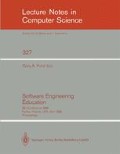Abstract
There are many tricks of the software trade; this paper has sampled just a few. The science and management techniques underlying software are essential to any career in software engineering, but these tricks are sometimes useful. Careful use of the tricks has catapulted more than one competent young programmer into software superstardom.
I don't think that these tricks should be given a one-hour lecture in a software engineering course. Some might deserve a ten-minute lecture here or a five-minute story there. But for the most part, tricks are learned through osmosis: your students will learn them as you apply them in lectures and as your teaching assistants apply them in software laboratories. And if they do learn these tricks, both your students and their employers will be grateful to you.
Preview
Unable to display preview. Download preview PDF.
References
Adams, J. L. [1979]. Conceptual Blockbusting, Second Edition, Norton.
Bentley, J. L. [1986]. Programming Pearls, Addison-Wesley, Reading, MA.
Bentley, J. L. [1988]. More Programming Pearls: Confessions of a Coder, Addison-Wesley, Reading, MA.
Bentley, J. L. and J. A. Dallen, Jr. [1987]. “Exercises in software design”, IEEE Transactions on Software Engineering, November 1987.
Brooks, Jr., F. P. [1975]. The Mythical Man-Month, Addison-Wesley, Reading, MA.
Cleveland, W. S. [1985]. The Elements of Graphing Data, Wadsworth, Monterey, CA.
Hofstadter, D. [1982]. “Number numbness, or why innumeracy may be just as dangerous as illiteracy”, Scientific American, May 1982. (Reprinted in Hofstadter's Metamagical Themas, Basic Books, 1985.)
Kernighan, B. W. and P. J. Plauger [1978]. The Elements of Programming Style, Second Edition, McGraw-Hill, New York, NY.
Lampson, B. W. [1984]. “Hints for computer system design”, IEEE Software 1, 1, January 1984.
Polya, G. [1945]. How to Solve It, Princeton University Press, Princeton, NJ.
Roueché, B. [1982]. The Medical Detectives, Washington Square Press.
Roueché, B. [1986]. The Medical Detectives, volume 2, Washington Square Press.
Strunk, Jr., W. and E. B. White [1979]. The Elements of Style, Third Edition, Macmillan, New York, NY.
Tufte, E. R. [1983]. The Visual Display of Quantitative Information, Graphics Press, Cheshire, CN.
Author information
Authors and Affiliations
Editor information
Rights and permissions
Copyright information
© 1988 Springer-Verlag Berlin Heidelberg
About this paper
Cite this paper
Bentley, J. (1988). Teaching the tricks of the trade. In: Ford, G.A. (eds) Software Engineering Education. SEI 1988. Lecture Notes in Computer Science, vol 327. Springer, New York, NY. https://doi.org/10.1007/BFb0043583
Download citation
DOI: https://doi.org/10.1007/BFb0043583
Published:
Publisher Name: Springer, New York, NY
Print ISBN: 978-0-387-96854-4
Online ISBN: 978-0-387-34779-0
eBook Packages: Springer Book Archive

